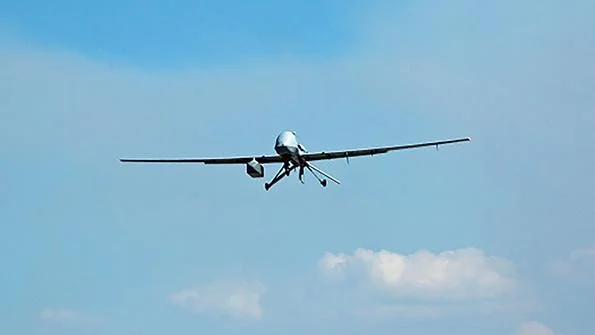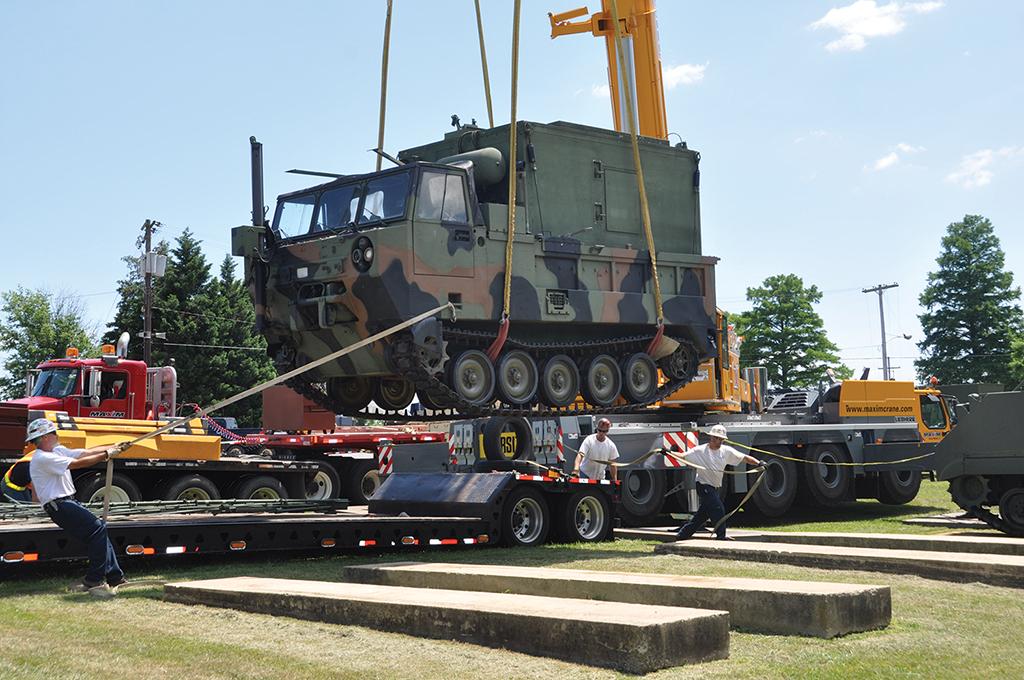
Blasphemy showed up for the first time on a U.S. Army unmanned aircraft system last summer.
Besides the provocative name of the Army’s mission pod, almost nothing else is known about Blasphemy. When the pod appeared on a briefing slide about a demonstration of advanced electronic warfare capabilities added to the General Atomics Aeronautical Systems MQ-1C Gray Eagle, an Army program manager declined to elaborate on what Blasphemy does.
- New Army and Navy electronic attack concepts emerge
- Air Force nears new Compass Call upgrade
A 2017 U.S. government contract document indicates only that Blasphemy is a product of the Air Force’s Big Safari project office, which specializes in secret electronic warfare and communications upgrades for aircraft.
In a larger sense, Blasphemy represents the vanguard of a six-year-old scramble by the Defense Department to reconstruct and modernize a once-impressive arsenal of offensive electronic warfare capabilities that was diminished, and in some cases abandoned, in the past two decades.
Over the next few years, Blasphemy, the Army’s Lockheed Martin Multi-Function Electronic Warfare-Air Large (MFEW-AL) and the Navy’s Lockheed Advanced Off-Board Electronic Warfare (AOEW) systems should enter service to swing the initiative in the electromagnetic spectrum back to the U.S. military.
A decade of spending is expected to establish a new baseline of offensive electronic warfare capabilities to supplement the largely defensive, self-protection systems that dominated Pentagon spending during two decades of conflict mainly against insurgents and terrorists.
At the same time, the Air Force and Navy are launching critical programs for their most advanced electronic platforms, with new standoff jammers for low-band early-warning radars entering development for the new fleets of the Air Force’s EC-37B Compass Call and the Navy’s Boeing EA-18G Growlers.
In establishing the mid-2020s baseline, the Defense Department also is emphasizing a new approach, with an architecture set up to be rapidly and affordably upgraded.
The next wave of electronic warfare investments will include a focus on leveraging latent electronic warfare capabilities of already fielded systems.
In late 2019, for example, the Pentagon’s research and engineering (R&E) branch selected seven companies to participate in a new prototyping program.
Instead of designing a new generation of jammers, the focus of the prototyping program is to modify existing radars and communication antennas.
By harnessing artificial intelligence, says Jim Faist, former director for advanced capabilities in R&E, a new software-enabled mode could be added to radars, allowing the apertures to simultaneously search for targets and jam hostile emitters.
Of the seven companies selected in 2019, the Defense Department is scheduled to pick two prototyping proposals this year to start developing hardware, according to the Pentagon’s budget justification documents.
Such high-level interest in electronic combat marks a reversal after decades of budget-driven decisions that consolidated electronic warfare capabilities onto a small number of platforms.
The Army, for example, retired a fleet of mobile jamming systems, such as the MLQ-34 Tacjam from military intelligence battalions with no replacement, trusting in other services to provide communications jamming support for modular brigade combat teams. Moreover, the Army’s priority after 2001 shifted to defensive jamming systems to face the new threat of disabling trigger devices for improvised explosives aimed at resupply convoys in Afghanistan and Iraq.

But two different events in the first half of the last decade changed the Pentagon’s stance on electronic warfare. In 2014, the Russian invasion of Ukraine offered a new case study in modern electronic warfare capabilities: Russian units were able to jam Ukrainian communications and radars, interfere with control links to unmanned aircraft systems (UAS) and spoof command-and-control networks seemingly at will. U.S. military forces also reported a similar experience in Syria, attributing attacks by Russian allies to the geolocation and jamming devices provided from Moscow.
By 2017, the Army had developed a new strategy. The MFEW-AL, leveraging investments in the Marine Corps’ Intrepid Tiger jamming pod, would form a new UAS-borne aerial layer of offensive electronic attack capabilities. The MFEW-AL would then be combined with the Terrestrial Layer System (TLS), delivering a multidomain replacement for Tacjam and the smaller TLQ-17A Traffic Jam systems from the Cold War era.
Unlike Cold War-era capabilities, the offensive elements integrated into the TLS may not be limited to ground vehicles. In June 2019, the Army published a request for information that revealed a new concept for a TLS-Extended Range (TLS-ER) system. The concept proposed delivering cyber- and electronic-attack payloads via artillery rounds at targets up to 1,000 km (620 mi.) downrange, likely using the future Lockheed Precision Strike Missile. The TLS-ER also included concepts for releasing similar payloads from stratospheric airships.
Queuing the TLS-ER would be a new fleet of UAS- and helicopter-based signals intelligence and electronic attack payloads: the MFEW-AL.
In March 2020, the Army started testing the first MFEW-AL pod on board a de Havilland Canada DHC-6 Twin Otter, which is serving as a testbed. The payload was glimpsed again in August 2020 as part of the same demonstration on board the MQ-1C that involved the Blasphemy pod. By the middle of the decade, a fully networked system of airborne MFEW-ALs and ground-based TLS units will restore the Army’s organic capability for offensive electronic attack. A new MFEW-Air Small is planned to be integrated on Textron’s AAI Corp. RQ-7 Shadow fleet. Another version is planned to be hosted on a helicopter, perhaps the Boeing AH-64E Apache.
The Navy, by contrast, never relinquished organic electronic attack capabilities. In addition to maintaining and upgrading the EA-18G’s airborne jamming systems, the Navy also has been keeping up to date the shipborne SLQ-32. The Surface Electronic Warfare Improvement Program delivered an enhanced solid-state transmitter to the SLQ-32(V) in Block 3. Meanwhile, a planned Block 4 upgrade will introduce a new capability for electronic attack against an enemy’s longwave infrared targeting systems as well as detection of electro-optical and infrared sensors.
The Navy’s ships, however, face new forms of attack. A new generation of anti-ship ballistic missiles, cruise missiles and hypersonic glide vehicles fielded by China threaten to overwhelm ships’ electronic and kinetic defenses. So the Navy is introducing a new countermeasure.
Since 2018, Lockheed has been developing the Active Mission Payload (AMP) under the AOEW program. When the AOEW system is integrated on a Lockheed-Sikorsky MH-60R, the Navy has publicly described the pod’s role as an offboard decoy, fooling incoming missiles to stray far away from their intended targets.
Lockheed officials, meanwhile, have also hinted that the AOEW payload includes capabilities beyond serving as an electronic decoy, which suggests an ability to electronically disable the guidance or other electronic systems on board an incoming missile.
The AOEW program would help by extending the reach of ship-based electronic attack transmitters but remains limited to the range and endurance of the MH-60R. Just as the Army has proposed the TLS-ER concept, the Office of Naval Research (ONR) also has an idea for dramatically extending the range of the AMP’s capabilities. In 2019, the ONR released a request for information for the Long-Endurance Advanced Offboard Electronic Warfare Platform (LEAP). The details remain secret, but the solicitation pointed to developing a ship-launched UAS that could remain airborne for a significant period.
The Navy and Air Force are also revitalizing the traditional platforms of electronic attack. Raytheon has delivered the Next-Generation Jammer (NGJ) Mid-Band pod for the EA-18G to test. Meanwhile, the Navy selected L3Harris in December to develop the NGJ-Low-Band pod, which could be the Navy’s answer to Russia’s Nebo-M air defense system, which features a VHF-band, active, electronically scanned array radar.
The Air Force also is quietly developing a similar capability for the Compass Call fleet. The Baseline 3 version of the Compass Call standoff jamming system is now being rehosted from the Lockheed EC-130H to the Gulfstream EC-37B. As soon as that transition is completed, by 2025, the Air Force will begin integrating the Baseline 4 version of Compass Call, which introduces a new low-band jammer system.





